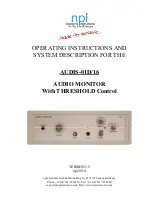
96
24. RA-6 Deflection Circuit Troubleshooting
Chapter 24 - RA-6 Deflection Circuit Troubleshooting
The deflection circuits in the RA-6 chassis are identical to the RA-5A chassis in that horizontal sweep and HV are
generated in separate circuits.
Horizontal Deflection Troubleshooting
Referring to Figure 24-1, horizontal sweep is generated in the conventional way using an H drive signal from pin
40 of IC309 on the A board. It is amplified and transformer coupled to the horizontal output transistor Q8024.
The deflection yokes and T8003 are driven. T8003 generates 200VDC for the dynamic focus correction circuit
and a ± 100V source to provide offset of the red and blue deflection yokes for centering to the green CRT.
Horizontal centering control is also provided by IC8012 and Q8039.
IC8005 is a PWM control device that serves to modulate the horizontal output B+ level to T8003 for pincushion
correction. The H pulse at pin 14 provides the timing for the sawtooth reference while the E – W signal supplies
the necessary vertical parabola signal for scan width modulation.
Q8031 and Q8101 buffers and shapes the H pulse for use in OSD timing and, more importantly, tells the H
protect circuit that horizontal sweep is occurring.
Since there is no flyback transformer incorporated into this circuit, current demands on the horizontal output
transistor are lower and damage from CRT and flyback arcs are nonexistent. This also makes troubleshooting
easier. Loss of horizontal deflection is likely to occur because of Q8024 failing. It is wise to check Q8027 when
this happens since it is easily damaged from the large current surge when Q8024 shorts and it also may have
been the reason for the failure. Powering up this circuit at low B+ levels using a variac is not possible. The main
power supply will not operate at AC input levels below 70V. This is sufficient input to produce full secondary
voltages and the new transistor could fail if other problems are still present. There is, however, a way to utilize
the soft start feature of the power supply to get an initial idea of the status of this circuit.
Place an oscilloscope probe near Q8027 and set the gain to 500mv. Set sweep for horizontal frequency viewing.
Apply 120VAC to the set while watching the scope. The soft start in the main supply will keep initial current at
approximately 50% of normal level for about three seconds. In this chassis, initial AC current will start at 700ma
and rise to 1.5A. If the horizontal stage has a problem such as a defective T8003 or deflection yoke, the initial
current will begin a much higher levels and the unit will go into protect. If this is happening, try to view the signal
at Q8027 during this period for the presence of pulses. If the transformer or a yoke is defective and caused the
original failure, a distorted (if any) waveform will appear. If clean H pulses appear before the shutdown, suspect
excessive loads on T8003 or a problem with the horizontal regulator IC8005 and Q8027. Note: A common cause
of secondary loads on T8003 is CRT drivers that have shorted and loading the 200V line.
Pincushion Troubleshooting
The simplicity of the pin correction circuitry in this chassis should provide for easy troubleshooting. The key
symptom to observe is whether the picture is stretched or of insufficient width with pincushion distortion.
Picture Too Wide: Q8027 is not modulating the scan width accordingly and is either shorted or in saturation.
There should be approximately a 15V difference between the source and the drain. Shorting the gate of Q8027
will aid in determining whether IC8005 is overdriving it or the transistor is at fault. If the picture width is substantially
reduced, check IC8005 for missing H pulse at pin 14 before replacing.
Insufficient Width: Q8027 is not receiving pin correction signals. Check for a parabolic signal at the gate. If not
present, verify the E –W signal is at pin 6. If it is, check the associated components around IC8005 before
replacing it. Pay close attention to the components supplying feedback to the operational amplifiers in this IC.
Beware that the NVM IC storing the pincushion correction data has caused problems in some previous models.
















































